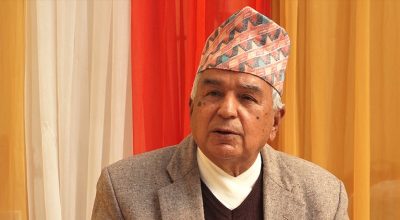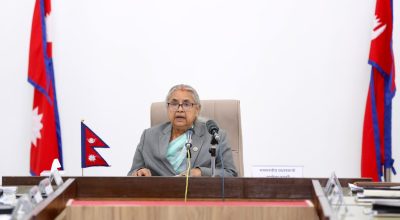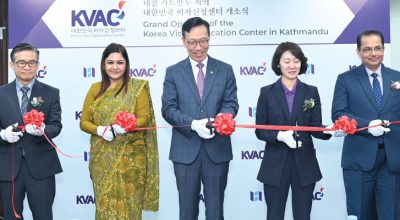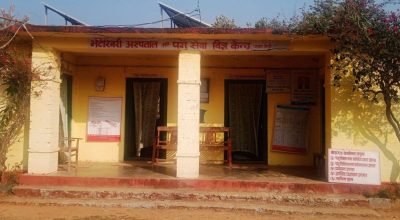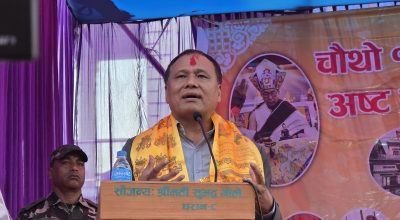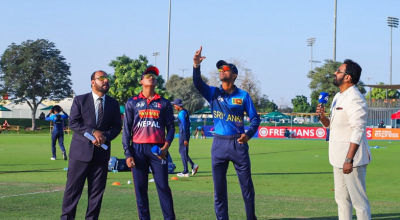
Hemanta Joshi
Kathmandu, August 6: The Millennium Challenge Corporation (MCC) Compact that was signed between the Ministry of Finance and the US Government around six years ago has reached the entry into force (EIF) phase and the development itself marks a significant milestone in the implementation of the agreement.
According to the Millennium Challenge Account (MCA)-Nepal Development Committee, preparations are on to announce date for EIP regarding the MCC soon.
Over the course of six years since signing of the agreement, the Compact was endorsed by the Federal Parliament along with a 12-point descriptive note. During this period, Nepal has met almost all conditions, five out of six, required to be enabled by it before advancing the agreement to the implementation phase. Of six pre-requites, land acquisition for the implementation of the Pact has been awaited.
However, over the course of time, Nepal is needed to own up additional economic responsibility for initiations and projects to be implemented under the agreement. Initially, it was agreed that 500 million USD shall be provided in grants to Nepal while the government shall bear 130 USD, expecting the total cost of the MCC project to remain at 630 million USD.
But the ‘supplemental agreement’ over the MCC that was signed in last May-June, demands the government to bear additional 67 million USD, seeking its total contribution of 197 million USD to the enforcement of the agreement. In the beginning, Nepal was supposed to take up the 20.63 per cent economic responsibility for the MCC project and now it rose to 28.26 percent. The increased responsibility amount is equivalent to Rs 900 million.
The preparations for the announcement of EIF date sans meeting all the preconditions is another concern regarding the implementation of projects under the MCA-Nepal, the government agency formed to implement the projects co-funded by the US government under the MCC.
The acquisition of land for the implementation of MCC Nepal Compact projects, as well as the guarantee of the land use rights within forest areas is still awaited.
The Compact mandates the project implementing body to complete the projects within five years of the declaration of EIF. The prevailing time provides room to doubt over the completion of the projects within the stipulated timeframe.
This article primarily highlights the factors contributing to the increase in the cost of Compact implementation and sheds light on the reasons behind the decision to proceed with the Entry into Force (EIF) without fulfilling all the prerequisites.
Factors contributing to additional responsibility for Nepal
The Council of Ministers on May 23 decided to endorse the Finance Ministry’s proposal to revise the agreement between Nepal and the MCC and increase the government’s share to its implementation. On the basis of the same agreement, Nepal Electricity Authority (NEA) and the MCA-Nepal on May 30 signed the ‘supplemental agreement’.
Two days ago, NEA and MCA-Nepal signed the agreement. The MCA-Neal issued a public statement citing that “The government has decided to include additional endevours included in the electricity transmission projects under the MCC Compact on the request of the Nepal Electricity Authority.” The statement further mentioned that the additional budget of 67 million US dollars required to implement these additional endeavors will be managed from the major budget of the Compact. In the event of the full utilization of the allocated budget, any insufficient funds will be borne by the NEA.
The additional budget to be required for the implementation of the Compact is to be considered as the government’s contribution to it and it will be adjusted in the relevant schedule of the Compact through the implementation letter. Road and electricity projects are the areas of priorities for Nepal identified by the MCC Compact signed in September 14, 2017.
As per the statement, the cost amount of USD 67 million which has been recently added will be spent for the construction of the section of the 400kV New Butwal-Gorakhpur Nepal-India Inter-country Transmission line towards the Nepal side and for increasing the capacity of three substations. This transmission line project is in the construction process at present.
However, it is not clear why the additional budget for the heading of construction of transmission line from New Butwal Substation to the India border that is already mentioned before in the MCC Compact.
The Schedule-1 (B) (1) of the MCC Compact states about the transmission line to be constructed under MCA-Nepal. It is mentioned in the Compact that around 300 kilometres of double circuit 400 kV transmission line would be constructed within Nepal.
The Compact states that the transmission line would be constructed on five different routes – from Lapsiphedi of Kathmandu up to Ratamaate, from Ratamate to Hetauda, from Ratamate to Damauli, from Damauli to Butwal and from Butwal to the India border. This means that the plan of constructing the transmission line from Butwal to the India border for which the added cost has been managed is included in the existing cost of USD 630 million.
RSS had approached the MCA-Nepal for its comment regarding allocation of additional budget for the construction of the transmission line on this route the estimated cost of which has been already included in the Compact. In response, MCA-Nepal stated that the amount added in the MCC Nepal Compact programme would be merged with the Electricity Transmission Project budget and it would be used for increasing the capacity of three substations by installing extra ‘bays’ as per the requirement and request of Nepal Electricity Authority (NEA).
To RSS’ question whether the amount merged in this way can be termed as an increment in the project’s cost, MCA-Nepal’s information officer Rajib Dahal said the cost automatically goes up when extra work has to be carried out than what was previously determined.
“Additional work of expanding the capacity of the under-construction three substations by installing extra bays is being carried out from the amount added on behalf the Government of Nepal to the MCC Nepal Compact, as per the NEA’s need and request. The increase in cost is obvious after the addition of extra work on the pre-determined work. Therefore, we can call it as the need for additional investment due to the expansion of the limit of the project’s work,” the MCA-Nepal has stated.
Similarly, MCA-Nepal has said although some changes have been made in the works of Road Maintenance Project, it will not have any impact on the overall budget related to the roads.
NEA executive director Kulman Ghising said although the 18-kilometres route from New Butwal-Gorakhpur transmission line up to the India border has been included in the First MCA Compact, it was removed in between and later a decision was made to implement it under the Compact itself.
“India had already started the process for tender for the construction of the transmission line on its side, but in our case the dispute whether the MCC Compact would be endorsed by the parliament or not was not finalized. Therefore, we detached this from the MCC Compact,” Ghising said, adding that the tendering process of programmes under the MCC Compact also moves ahead after the parliament’s endorsement. “It was again included in the MCC after coming to the conclusion that only small contractors will come for the bidding when NEA does the contract for the project whereas big contractors would come if the MCA-Nepal calls for the contract. The cost increased after the NEA added to the scope of work that was already in the compact before.
Preparations for EIF without meeting prerequisites
Having been reached on 14 September, 2017 between the Finance Ministry of Nepal and the MCC, the agreement got endorsed from the parliament on 27 February, 2022.
The countdown for the five-year project will as per the agreement begin from the day of EIF. According to the preliminary agreement, EIF would take place from 30 June, 2020. However, many factors like a dispute in getting the compact endorsed from the parliament and other difficulties are blamed for the delay.
Land acquisition as a prerequisite for EIF has yet to take place.
According to Section 8.1 of Article 8 of the MCC Compact, the Government will ensure the full and expeditious cooperation of all relevant government entities to ensure that all land acquisition, site access, and forest clearance required to implement the Compact is provided in a timely manner, and consistent with all MCC policies.
Asked about the implementation of the compact, the MCC Nepal said the date for its implementation would be announced within coming the Nepali month of Bhadra. “Preparations are underway to announce the date for the implementation of the MCC Nepal Compact 2080,” said the MCC Nepal,” said the MCC Nepal.
It requires the total 1,471 hectares of land for the electricity transmission project, and around 20 hectares for the construction of a substation at Ratmate in Nuwakot. It requires 104 hectares of land for constructing around 856 electrical towers. There is still a dispute in the land required for constructing a substation, and the distribution of compensation for the land acquired for the transmission line has yet to begin, said the MCC Nepal.
“Except a family-disputed plot, the distribution of compensation for the land acquired for a substation at Ratamate has been completed. A preliminary legal process has initiated to acquire the land required to build the electrical towers.”
The legal process to determine compensation amounts for the land acquired for the project has started under the leadership of Chief District Officer of the respective district of the total nine affected districts, it has been said. The affected areas have 122 community and government forests.
Over Rs 10.8 billion allocated for the current FY
For the project, the government has allocated over Rs 10.8 billion for the current FY, 2023/24. Out of the allocated budget, Rs 8.7 billion will go for the electricity transmission project, Rs 1.5 billion for road repair, Rs 2 million for monitoring and evaluation, and Rs 555 million for administrative work. (RSS)







